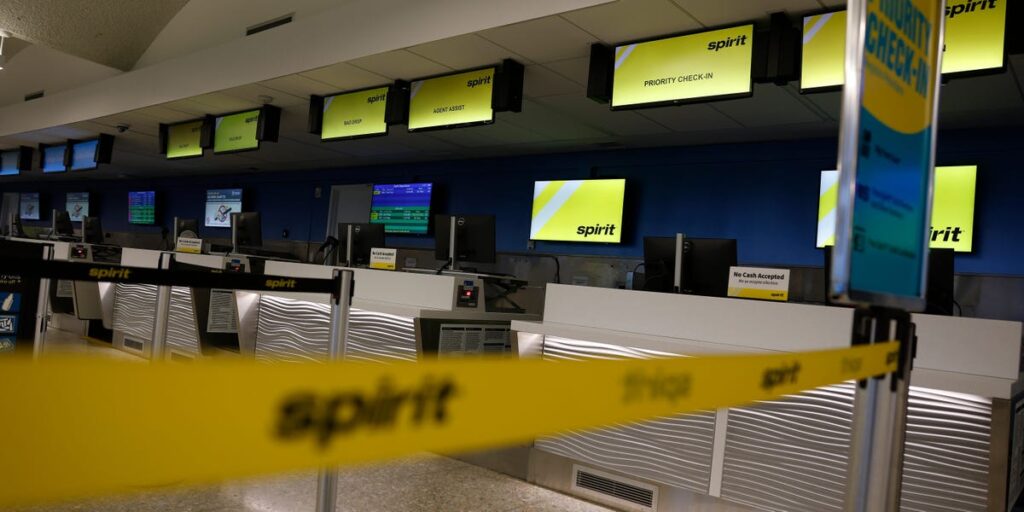Spirit Airlines’ second Chapter 11 bankruptcy in less than a year is creating whiplash as more customers lose access to low fares.
The Florida-based ultra-low-cost carrier has been entering and exiting markets for months as it attempts to focus on more profitable routes and dig its way out of a financial crisis.
Spirit CEO Dave Davis said in a memo to staff in mid-September that the carrier would slash a fourth of its flying by November compared to a year before.
Spirit confirmed to Business Insider on Wednesday that its latest cuts will be in Hartford, Connecticut, starting October 31, and Minneapolis, starting December 1. A spokesperson said the adjustment is part of Spirit’s restructuring plan “to focus on our strongest markets.”
“We apologize to our Guests for any inconvenience and will reach out to those with affected reservations to issue a refund,” they added.
They could not provide information on whether the airport employees, who are employed through third-party contractors, would lose their jobs or be offered relocation options.
Data from aviation analytics company Cirium shows both cities had seen restored service as Spirit increased its flying after emerging from its first bankruptcy in March, but the routes were slowly dropped until they were all officially axed from the network.
The move follows Spirit’s August exit from Seattle and its early September plan to cancel entry to Macon, Georgia, and leave 11 other airports starting in October. In line with Spirit’s ongoing start-and-stop trend, two of those had just started flying only months before.
Specifically, flights to Chattanooga, Tennessee, and Columbia, South Carolina, were launched for the first time in June, but the short-lived routes will be discontinued as of Thursday.
These are the 15 airports Spirit is exiting following its second bankruptcy filing:
Ending the week of October 2:
- Albuquerque, New Mexico
- Birmingham, Alabama
- Boise, Idaho
- Chattanooga, Tennessee
- Oakland, California
- Columbia, South Carolina
- Portland, Oregon
- Sacramento, California
- Salt Lake City
- San Diego
- San Jose, California
Other upcoming exits:
- Hartford, Connecticut: October 31
- Macon, Georgia: canceled future route
- Minneapolis: December 1
- Seattle: ended August 12
A possible boost for competitors
The over a dozen canceled airport leases will free up money as Spirit restructures, but Raymond James analyst Savanthi Syth said in August that the budget carrier’s exit could mean increased fares from competitors like Frontier Airlines and Southwest Airlines.
She added that when both Spirit and Frontier compete on certain routes, fares are typically 15% cheaper compared to when only one of the two operates.
Still, prices should stay lower than those of major carriers like Delta Air Lines or United Airlines.
The Association of Value Airlines, which represents Allegiant Air, Avelo Airlines, Frontier, Spirit, and Sun Country, said during a Senate hearing on Tuesday that the group’s average base fares are “less than $100” and its “all-in” prices are one-third the cost of major airlines.
And, while Spirit said it routinely adjusts service as needed, it still continues to fly to dozens of cities across the US, Latin America, and the Caribbean, and told BI that it does “not anticipate any additional airport exits in the near future.”
Bankruptcy: take two
Spirit filed for bankruptcy for a second time in August, just months after it had slashed $800 million in debt and emerged from its first bankruptcy filing in March.
The airline has largely suffered from increased labor and operating costs, as well as flyers seeking more premium options and opting for major airlines, even if it costs more. Despite Spirit’s first-class-like seats and new premium features, such as WiFi and fare bundling, these haven’t moved the needle.
Beyond the route cuts’ impact on customers, Spirit’s crew members are taking the brunt of the fallout. Spirit already furloughed hundreds of pilots in an effort to save on wages following its November 2024 bankruptcy filing, and sold millions of dollars’ worth of jets.
Then, in July, Spirit announced another round of pilot furloughs and downgraded over 100 captains to better align with its smaller flight schedule.
Now, it’s furloughing 1,800 of its roughly 5,200 flight attendants come December, and wants to shave $100 million in union-negotiated pilot salaries. Spirit pilots earn a base pay ranging from $84,000 to $270,000, depending on their position and seniority, as outlined in their current collective bargaining agreement.
On Tuesday, Spirit announced it has found some financial relief beyond reducing scheduled service. This includes securing up to $475 million in funding from existing bondholders and rejecting 27 leased planes from lessor AerCap, which will “reduce operating costs by hundreds of millions of dollars.”
Spirit’s reduced flying has one main bright spot — it has achieved podium status in terms of on-time performance. In September, the airline said, according to Department of Transportation data, it ranks third among all US carriers for reliability year-to-date.
Read the full article here


